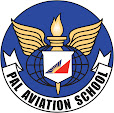Philippine Airlines Aviation School is one of the premier flight schools in the country. Being the first flying school in Asia, it is backed by decades of vast training experience in the realm of aviation.
 |
| Photos taken by F/O Edwin Baldado and F/O Paolo Padla |
PAL Aviation School is an Approved Training Organization of the Civil Aviation Authority of the Philippines. It has a fleet of 10 Cessna 172 Skyhawk aircraft used for flight training. The Cessna 172 Skyhawk is a four-seat, single-engine, high-wing fixed-wing aircraft.
 |
| The Cessna 172 Skyhawk is a single-engine, high-wing, fixed-wing aircraft. Photo taken by F/O Edwin Baldado |
PAL Aviation School also has one Red Bird SD and FRASCA 142 synthetic flight trainer used for the simulator training.
 |
| PAL Learning Center located at Padre Faura, Manila |
Flight training is held at the Omni Aviation Complex, Clark Field, Pampanga.
 |
PAL Aviation School at Omni Complex, Clark Field, Pampanga
|
Our Mission
The Philippine Airlines Aviation School’s Mission is to:
i. Support the Human Resources Training and Development Sub Department and Flight Operations Department objectives by providing qualified and highly proficient Flight Deck Crew.
ii. Support the corporate objective by making the services and facilities of the PAL Aviation School available to customers.
iii. Ensure the development and the well being of the PAL Aviation School personnel to enhance productivity.
Our Vision
The Philippine Airlines Aviation School’s Vision is to provide world class pilot training utilizing the best flight training equipment and facilities combined with highly competent Flight Instructors and support staff, and to be known as one of the best flight school in the world.
Our History
“Through these portals pass the BEST PILOTS OF THE PHILIPPINES”
In May 1960, Philippine Airlines entered into a joint venture with FEATI (Far East Air Transport Incorporated) to train pilots. This marked the birth of the first Aviation School in Asia, PAL-FEATI. Subsequently, the school was reorganized in 1964 into PAL Aviation School.
During the seventies, with the growing demand for pilots in the Asian region and being the only country that offers Pilot Training Course, other Asian countries sent their qualified nationals to be trained as pilots for their airlines. The Malaysian – Singapore Airlines (MSA) started sending Ab-initio pilot trainees to PAL Aviation School for training as First Officers with Commercial and Instrument Ratings on the Fokker Friendship F-27. The school continued to train Ab-initio pilots for Malaysian Airlines System (MAS) and Singapore Airlines Limited (SAL) even after each country had opted to fly their own flag carriers.
As a result of the favorable reports of the survey and evaluation of the aviation school facilities and standards of instructions by the UK-CAA, the first group of seventeen (17) Ab-initio trainees for MAS sponsored by Majlis Amanah Rakyat (MARA) of the Government of Malaysia continued their training as F-27 First Officers with Commercial and Instrument Rating with PAL Aviation School.
In the spirit of further strengthening and enhancing the bond between the Asian regions, the school’s facilities and services were made available to airlines and aircraft operators in the region. BOURAQ Indonesia Airlines, Bangladesh Biman Airlines, Air Niugini, Air Pacific, Air Lanka, and Bali Air, also started sending their pilots to PAL Aviation School for Ab-initio, up-grading and recurrent training.
Not only did the Aviation School of Philippine Airlines trained pilots for foreign countries but it also trained pilots for the Philippine Navy, Constabulary and Army.
PAL began offering flying courses to paying students in 1988 after the school was granted government recognition through a certificate issued by the Department of Education, Culture and Sports.
Through the years, PAL Aviation School carried on the tradition of training excellence that made it the primary source of Philippine Airlines’ corps of PRESTIGIOUS, PROFESSIONAL and COMPETENT PILOTS.
